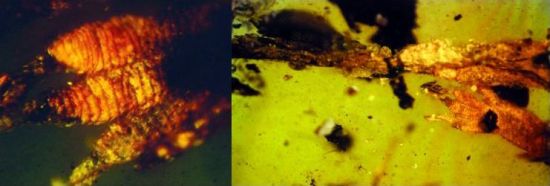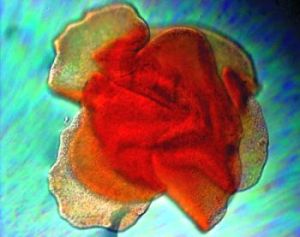Focus: creation news and views

‘Oldest’ amber gecko fossil
The discovery of a gecko’s lower limb, foot and part of its tail in amber ‘dated’ as being up to 110 million years old, has pushed back the supposed evolutionary origin of geckos by at least 40 million years.
So well preserved is the foot that it even shows the tiny finely divided setae (‘sticky toe hairs’) that give geckos their incredible ability to cling to ceilings and walls.
Adhesives engineers are trying to mimic that capability, but still have not been able to completely duplicate it—see creation.com/gecko—yet the gecko toe pads are supposed to have ‘just evolved’? And now that evolutionists can see that geckos they presume lived 100 million years ago have this same ability as modern geckos, they have an even greater challenge to explain how this could possibly have arisen by evolution.
Surely it makes much more sense to say that geckos have always been geckos, with all their design features in place from the beginning, just as one would expect from the Genesis account of Creation. The amber fossils are not millions of years old but only thousands—likely formed during the Flood of Noah’s day (see creation.com/amber).

In a paper in Palaeontology journal, the University of Manchester’s David Penney reported finding two spiders with identifiable ‘droplets of spider blood’ (hemolymph) in amber dated at up to 20 million years old. (He spoke of the possibility of extracting DNA from the blood.)
Gecko foot pads beautifully preserved, and droplets of spider blood, fit much more reasonably into a thousands-of-years timeframe, not millions.
- Zootaxa 1847:62–68, 11 August 2008.
- ScienceDaily, www.sciencedaily.com/releases/2008/09/080902163 920.htm, 3 September 2008.
- Palaeontology 48(5):925–927, 15 September 2005.
- ScienceDaily, www.sciencedaily.com/releases/2005/09/050930 082601.htm, 3 September 2005.
‘Primitive’ genome puzzle

The 1-mm-long placozoan (‘flat animal’) Trichoplax adhaerens, described as a ‘simple and primitive animal’, was first detected in the 1880s clinging to the sides of an aquarium. Recent analysis of its genome has left evolutionists scratching their heads.
One wrote: ‘It’s a puzzle why Trichoplax, a seemingly primitive animal, has such a complex genome.’
How complex? According to a member of the research team, ‘this animal’s genome looks surprisingly like ours’.
Actually, we ought not be surprised. God did not make anything ‘primitive’ but rather ‘very good’—fully functional for what it was designed to do. Note that similarities between the genomes of organisms of different created kinds reflect a common Designer, not common ancestry—the inconsistencies with the expectations of evolution underline that they were created.
- Nature 454(7207):955–960, 2008.
- Science 321(5892):1028–1029, 2008.
- ScienceDaily, www.sciencedaily.com/releases/2008/08/080820163002.htm, 23 August 2008.
Enceladus—telling a different story
The active geysers of Saturn’s moon Enceladus (Creation 29(1):9, 2006) continue to confound long-age cosmologists.
That’s because, on the basis of present evidence, Enceladus is ‘too small to generate enough heat to melt its water’, which means that the moon should have ‘frozen completely solid billions of years ago’.
Consequently, the obvious conclusion is surely that Enceladus must be substantially younger (right in line with the Bible’s timeline) than its mooted billions-of-years age. However, evolutionary cosmologists are rather saying that things must have been different in the past, e.g. that Enceladus had a more eccentric orbit.
Note that, facing the difficulty of explaining liquid water on Enceladus, evolutionists have happily departed from their oft-touted principle of uniformitarianism—viz., that the present is the key to the past. (Cf. the long-age geologists’ contention that Earth’s sedimentary layers could only be interpreted on the basis of present processes—i.e. the result of slow-and-gradual deposition over billions of years rather than being largely a legacy of the Genesis Flood.)
Also note that the evolutionary media have tried to turn the negative (for them) into a (they think) positive.
They say that the presence of liquid water means conditions on Enceladus could ‘make it ripe for life’.
But ‘water’ does not equal ‘life’—indeed, water breaks down the big molecules necessary for life (see creation.com/mars-water, creation.com/polymer).
- New Scientist 199(2670):7, 23 August 2008.
- Space.com, www.space.com/scienceastronomy/080619-am-en celadus-ocean.html, 19 June 2008.

Veins glorious
The title of their research paper summed it up: ‘Optimal vein density in artificial and real leaves’. The international team of biologists and engineers, ‘inspired by plant leaves’, had set out to build a microchannel transport network that would maximize distribution of fluid via evaporation-driven flow. They worked out the optimization formula for channel distance/thickness in their artificial substrate, and then found that it also described the placement of veins in leaves.
In other words, you couldn’t engineer a more efficient venation pattern than what you find in real leaves.
Note that despite acknowledging that the leaf channel networks ‘reveal basic design principles’ [emphasis added], the researchers ascribed them to ‘the long evolution of vascular plants’, not to a Designer.
- Proceedings of the National Academy of Sciences USA, 105(27):9140–9144, 8 July 2008.
Ivanov ‘scandal’
A decade ago, when the newly opened Russian government archives revealed details of biologist Ilia Ivanov’s attempts to create an ape-human hybrid in the 1920s, it made international headlines.
Why had Ivanov’s project, which included expensive expeditions into Africa, been both sanctioned and financed by the Bolshevik government at a time when few Russians were allowed to leave the country? Some suggested that the military com manders aimed to breed super-strong hairy ape-man warriors for what The Sun in London referred to as ‘Stalin’s mutant ape army’. However, neither Ivanov’s nor the government’s actual motives for the project were spelled out clearly in the archive documents.
University of Cambridge specialist in Russian history, Soviet-born Alexander Etkind, in a recent journal paper entitled ‘Beyond eugenics: The forgotten scandal of hybridizing humans and apes’, believes he has the answer. Etkind says that when Ivanov put his proposal to the authorities, he painted it as the experiment that would prove men had evolved from apes.
‘If he crossed an ape and a human and produced viable offspring then that would mean Darwin was right about how closely related we are,’ Etkind says. Ivanov’s approach to the government stressed how proving Darwin right would strike a blow against religion—Ivanov of course knowing that religion was something the authorities ‘were struggling to stamp out’.
Etkind’s observations bear out our earlier article about Ivanov (Creation 29(1):32–33, 2006) and information provided subsequently by a correspondent (creation.com/superwarrior).
Note that it wasn’t only the Bolshevik government that financed Ivanov’s vision. Etkind writes that when news of Ivanov’s proposal reached the USA in the 1920s, ‘The American Association for the Advancement of Atheism announced its fund-raising campaign to support Ivanov’s project but gave it a scandalously racist interpretation.’
Scandalously racist? Actually, racism is a logical outflow of evolutionary teaching (see creation.com/racism)—wherein lies the real scandal.
(See also our feature on Stalin in this issue, p. 52.)
- Studies in History and Philosophy of Biological and Biomedical Sciences 39(2):205–210, 2008.
- New Scientist 199(2670):48–49, 23 August 2008.
People killed off Australian megafauna
The long-running debate between certain evolutionists in Australia as to how its ‘megafauna’ became extinct seems to have firmed in favour of the ‘humans ate them’ view.
A fossil find in a Tasmanian cave has convinced leading evolutionists that ‘the mass extinction’ of Australia’s large animals was ‘the result of human hunting and not climate change’.
According to Richard Roberts of the University of Wollongong, and his colleagues Tim Flannery (Macquarie University) and Craig Reid (Queen Victoria museum), ‘We’ve now shown that megafauna were in Tassie until people arrived.’
They may well be right about that—it is just what creationists have been saying for years. But the evolutionary time frames that portray the first people arriving in Australia 40,000 or more years ago are wrong.
There is evidence consistent with a much more recent arrival, within the post-Flood, post-Babel time frame (creation.com/aborig).
As for the faunal extinction, it makes sense that the hunters would have preferentially targeted larger prey—Aboriginal accounts of such ‘megafauna’ persist today (creation.com/giantegg). Similarly, the demise of the dinosaurs might also have been contributed to by man (despite the unwillingness of the proponents of millions-of-years time frames to consider this, notwithstanding evidence that man and dinosaurs have indeed coexisted—see creation.com/dinosaurs).
- The Courier Mail (Qld, Australia), 12 June 2008, p. 17.
False ‘Flood’ prophet
The global-warming/climate-change doomsayers have been getting a lot of press. New Scientist recently allocated a full page for author Stephen Baxter to opine and promote his new novel Flood—‘a fictional account of global inundation’ which Baxter hopes ‘will persuade people to engage with the realities of climate change’.
Baxter does not believe that the global Flood of Noah’s day was a real event. He attributes the widespread flood accounts in many cultures to ancestral memory of coastland inundation by a post-ice-age rise in sea level.
Creationists are often challenged as to the source and amount of water needed for the Genesis global Flood (see ch. 12, The Creation Answers Book, available addresses p. 2). Baxter is aware his warning of a future ‘megaflood’ is likely to be similarly challenged. He writes: ‘Some scientists believe Earth may contain a great deal more water than is present in its oceans and ice caps. … —perhaps as much as five times the volume of the surface waters and more than enough to engulf the continents.’
Baxter concludes: ‘I hope that my flood, a reworking of a primal myth, will make us realise how dependent we are on the whims of a giant and restless planet.’
We ought not be surprised that there are people like Baxter who ‘deliberately forget’ that the global Flood of Genesis 6–9 was a real event, as God warned in advance (2 Peter 3:3–6). Yet he is prepared to propose something similar to advance the ‘climate change’ cause.
Of course, even if sea levels were to rise somewhat, God promised (sealed with the sign of a rainbow) that He would never again destroy the earth in a Flood (Genesis 9:11, Psalm 104:7–9). But fire—that’s a different matter (2 Peter 3:7).
(Many Creation readers have enquired as to CMI’s position re ‘global warming’—see creation.com/warming.)
- New Scientist 199(2665):18, 19 July 2008.
Is God ‘She’?
Nearly three-quarters of Christians in Britain who responded to a poll think that God is male, compared with less than half of the general population, according to a Populus survey conducted for the Movement for Reform Judaism. One percent believe that God is female.
Christians believe that our knowledge about God is what He has revealed to us Himself in the Bible. God is Spirit (John 4:24), so He is biologically neither male nor female, and does not have a sexual nature. He is described in male terms of Father, King and Master, because that best describes how He relates to His creation. Jesus prayed to Him as Father and taught His disciples to do the same (Matthew 6:9). God the Son, Jesus Christ, became incarnate as a man, not a woman, and Jesus referred to the Holy Spirit by the pronoun ‘He’ (John 14:16–17).
Calling God by the male names He has given Himself in no way reflects negatively on the biblical view of women, because both men and women are created in the image of God (Genesis 1:26–28).
However, the use of unbiblical female terminology for God does not elevate women, but is an attempt to redefine God Himself. He is no longer Lord over the world, but a mother birthing it; the world is actually part of ‘her’ body. The same faulty hermeneutic that allows replacement of ‘Father, Son and Holy Spirit’ with ‘Mother, Daughter, and Life-bearing Womb’ would also free people to reinterpret any part of Scripture to fit with the spirit of the age.
For more on this subject, see Lita Sanders’s article, ‘What’s in a pronoun? The divine gender controversy’.
- The Times (UK), 19 May 2008, p. 25.


Our incredible brains
Researchers have found that cilia, which are fine, moving, hair-like extensions of cells, are necessary for the development of new nerve connections in the brain. (Cilia are actually a type of motor, which in turn contain even tinier motors—see By Design pp. 140–141.) Mice genetically engineered to lack the cilia developed abnormal brains. Evolutionists had proposed that the cilia were left-overs from the time when we were supposedly microbes swimming around (using the cilia) in the primordial soup. As the Yale University report said, ‘The cilia found on brain cells of mammals until recently had been viewed as a mysterious remnant of a distant evolutionary past, when the tiny hair-like structures were used by single-celled organisms to navigate a primordial world.’
Many acknowledge that the human brain is the most organized mass of matter in the universe. Such organization speaks of intelligent creation, not matter organizing itself. Indeed, if our brains are merely the product of dumb matter undergoing countless mindless rearrangements, why should we trust the thoughts that come from them?
- Proceedings of the National Academy of Sciences USA 105(35):13127–13132, 2 September 2008.
- Yale University press release, opa.yale.edu/news/article.aspx?id=5935, 11 August 2008.
High-powered boo-boo
Evolutionary enthusiasm can overpower reason, even in top academic circles. A recent scientific news report states that scientists at Penn State (a major US ‘Ivy League’ university) have a new computational approach that they say will assist in understanding ‘how life began on Earth’.
The report says: ‘The team’s method has the potential to trace the evolutionary histories of proteins all the way back to either cells or viruses, thus settling the debate once and for all over which of these life forms came first.’
So viruses could have evolved before cells? But a virus has no way of replicating itself—no machinery to do the job. A virus is really not much more than a package of code (DNA or RNA). To make copies of itself, it needs to have a living cell available, so it can ‘hijack’ that cell’s machinery to replicate the virus. Thus, there have to be cells around before viruses can reproduce.
So unfortunately for evolutionists, they still have to explain how in their scenario something with all that machinery for replication (a fully functioning cell) arose from chemicals—before there was any replication, thus before there was any selection. No matter how much they would like to have something far simpler, like a virus, at the base of their imaginary ‘tree of life’, it’s a no-starter.
- Penn State news alert, www.science.psu.edu/alert/Patterson8-2008.htm, 2 September 2008.

Low drag on dragonflies
Dragonflies can glide for up to 30 seconds without flapping, yet their wings do not conform to the aviation industry’s ideal of a streamlined cambered wing. Instead, the dragonfly’s wing surfaces are highly corrugated, with stiffening pleats across their span.
It turns out that the pleats are not just for strength, but have an aerodynamic function as well. Researchers using a fluid dynamics simulator found that the pleats give the wings much greater lift in gliding flight than expected, ‘matching and sometimes bettering that of a similarly sized streamlined wing.’ Air circulating in the hollows between the pleats creates areas of very low drag, aiding the lift-generating flow of air across the wings.
It beggars belief that the dragonfly’s design features could have been anything other than intelligently designed. (See also creation.com/dragonfly about their tracking system.)
- New Scientist 198(2661):19, 21 June 2008.
- Bioinspiration and Biomimetics 3(2):26004–260017, 2008.
Eye inspires improved camera technology

The vertebrate eye has been roundly criticised by evolutionist Richard Dawkins and other strident anti-creationists as being ‘badly designed’. But ophthalmologists have pointed out that such an idea comes from a lack of knowledge of eye function and anatomy (see ‘Fibre optics in the eye’, pp. 45–47).
And engineers writing in Nature journal recently recognized good design when they saw it: ‘The human eye is a remarkable imaging device, with many attractive design features.’ Of particular interest to them is the eye’s ‘hemispherical detector geometry’ which enables ‘a wide field of view and low aberrations with simple, few-component imaging optics’. Thus inspired by the eye’s curved imager, the researchers have set about developing a ‘hemispherical electronic eye camera’—described by others as ‘an outstanding contribution’, one which heralds dramatic progress in photographic and other optoelectronic technology.
In the light of this and other breakthroughs in imaging technology inspired by the eye, the ‘bad design’ brigade ought to consider this: If the eye really is badly designed, then why are so many engineers trying to copy what it can do?
- Nature 454(7205):703–704, 748–753, 7 August 2008.

God on trial?
Filming has begun in Scotland of God on Trial, a 90-minute BBC drama that depicts Jews in Auschwitz concentration camp putting God ‘on trial’ during WWII. Three judges listen to evidence from both believers and atheists as to whether God is to blame for the terrible acts of humanity.
The film asks ‘how can there be so much suffering in the world, and what kind of a god could let such things happen?’ Executive producer Mark Redhead is reported to have said, ‘To me, it seemed time that he was called into account.’
Given the humanist stance of so many BBC documentaries, we have little doubt as to what the film’s ‘verdict’ will be. However, we have news for the scriptwriter and producer. The Creator God gave our first parents, Adam and Eve, free choice as to whether they would obey Him or not. They chose not to, and ever since then every one of us has chosen not to also. As a result we all live in a cursed world, with death and suffering (creation.com/plant_death, creation.com/death), where men wilfully commit evil. However, God has provided the way for us to be reconciled to Him—through the death and resurrection of His Son, the Lord Jesus Christ. Believers are not promised freedom from harm in this life. We are, however, promised the grace to bear and oppose the evil we encounter.
As to a trial and judgment, God has appointed a day in which He will be the one who does the judging (Acts 17:31; Revelation 20:11–15).
- Sunday Herald (Scotland), www.sundayherald.com/business/businessnews/display.var.1961636.0.god_on_trial_heads_new_bbc_drama_highlights_for_2008.php, 14 January 2008.
- BBC press release, www.bbc.co.uk/pressoffice/pressreleases/stories/2008/01_january/17/god.shtml, 17 January 2008.

Galactic magnetic mystery
The favoured long-age evolutionary theory as to how galaxies came to have ‘mysteriously massive’ magnetic fields is that they ‘spin’ them over many billions of years. But a recent study of light from distant quasars ‘is casting serious doubt’ on that idea.
One of the researchers relates: ‘What we found, somewhat surprisingly, is that magnetic fields, as far as we can look back, are as strong as they are today.’
New Scientist summed it up: ‘Young galaxies could not have spun enough times to have built up such large magnetic fields, or so theory suggests.’
- Nature 454(7202):302–304, 17 July 2008.
- New Scientist 199(2665):14, 19 July 2008.









Readers’ comments
Comments are automatically closed 14 days after publication.